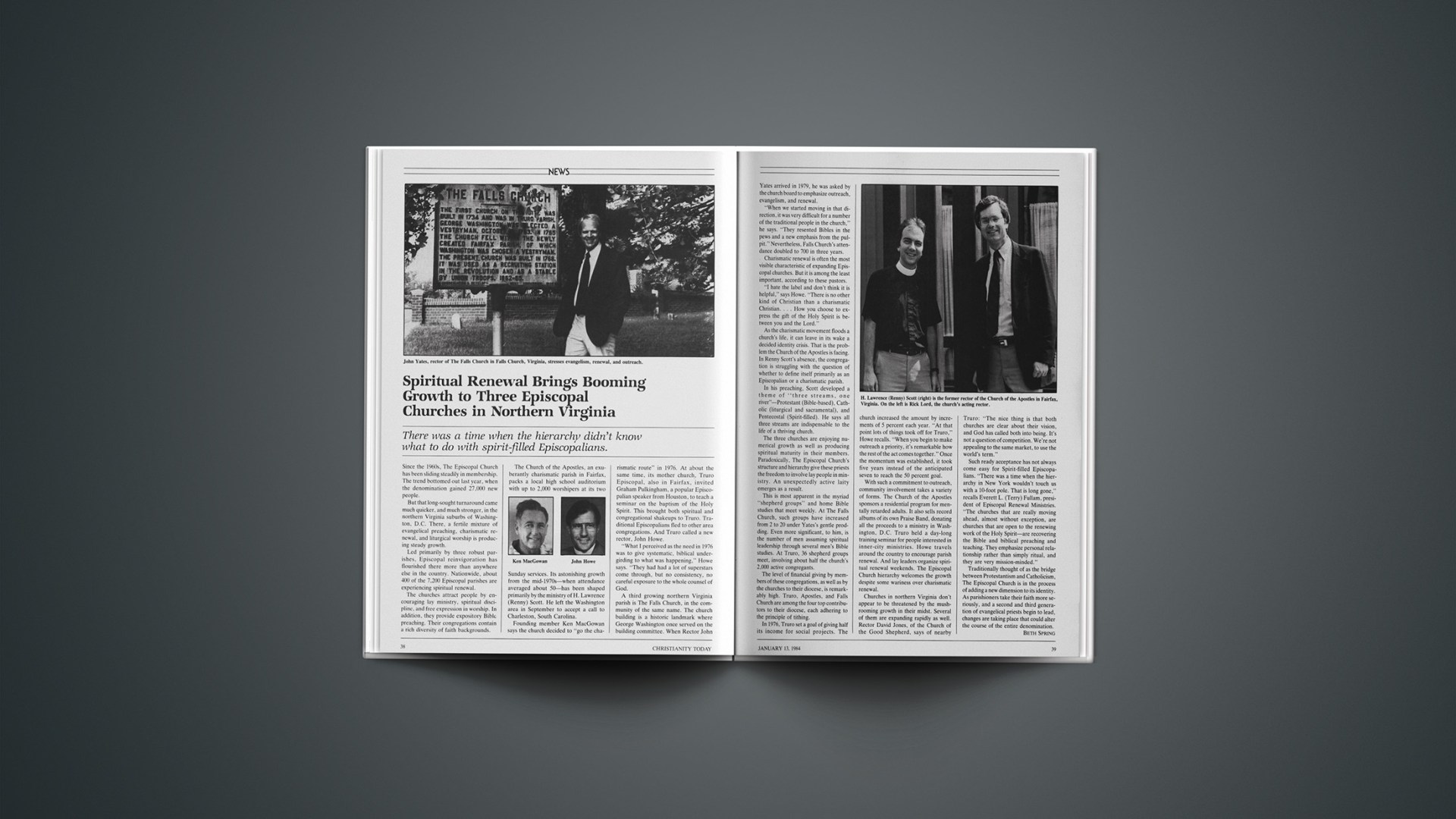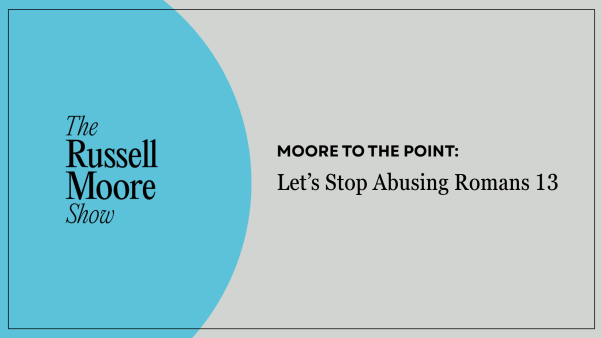There was a time when the hierarchy didn’t know what to do with spirit-filled Episcopalians.
Since the 1960s, The Episcopal Church has been sliding steadily in membership. The trend bottomed out last year, when the denomination gained 27,000 new people.
But that long-sought turnaround came much quicker, and much stronger, in the northern Virginia suburbs of Washington, D.C. There, a fertile mixture of evangelical preaching, charismatic renewal, and liturgical worship is producing steady growth.
Led primarily by three robust parishes, Episcopal reinvigoration has flourished there more than anywhere else in the country. Nationwide, about 400 of the 7,200 Episcopal parishes are experiencing spiritual renewal.
The churches attract people by encouraging lay ministry, spiritual discipline, and free expression in worship. In addition, they provide expository Bible preaching. Their congregations contain a rich diversity of faith backgrounds.
The Church of the Apostles, an exuberantly charismatic parish in Fairfax, packs a local high school auditorium with up to 2,000 worshipers at its two Sunday services. Its astonishing growth from the mid-1970s—when attendance averaged about 50—has been shaped primarily by the ministry of H. Lawrence (Renny) Scott. He left the Washington area in September to accept a call to Charleston, South Carolina.
Founding member Ken MacGowan says the church decided to “go the charismatic route” in 1976. At about the same time, its mother church, Truro Episcopal, also in Fairfax, invited Graham Pulkingham, a popular Episcopalian speaker from Houston, to teach a seminar on the baptism of the Holy Spirit. This brought both spiritual and congregational shakeups to Truro. Traditional Episcopalians fled to other area congregations. And Truro called a new rector, John Howe.
“What I perceived as the need in 1976 was to give systematic, biblical undergirding to what was happening,” Howe says. “They had had a lot of superstars come through, but no consistency, no careful exposure to the whole counsel of God.
A third growing northern Virginia parish is The Falls Church, in the community of the same name. The church building is a historic landmark where George Washington once served on the building committee. When Rector John Yates arrived in 1979, he was asked by the church board to emphasize outreach, evangelism, and renewal.
“When we started moving in that direction, it was very difficult for a number of the traditional people in the church,” he says. “They resented Bibles in the pews and a new emphasis from the pulpit.” Nevertheless, Falls Church’s attendance doubled to 700 in three years.
Charismatic renewal is often the most visible characteristic of expanding Episcopal churches. But it is among the least important, according to these pastors.
“I hate the label and don’t think it is helpful,” says Howe. “There is no other kind of Christian than a charismatic Christian.… How you choose to express the gift of the Holy Spirit is between you and the Lord.”
As the charismatic movement floods a church’s life, it can leave in its wake a decided identity crisis. That is the problem the Church of the Apostles is facing. In Renny Scott’s absence, the congregation is struggling with the question of whether to define itself primarily as an Episcopalian or a charismatic parish.
In his preaching, Scott developed a theme of “three streams, one river”—Protestant (Bible-based), Catholic (liturgical and sacramental), and Pentecostal (Spirit-filled). He says all three streams are indispensable to the life of a thriving church.
The three churches are enjoying numerical growth as well as producing spiritual maturity in their members. Paradoxically, The Episcopal Church’s structure and hierarchy give these priests the freedom to involve lay people in ministry. An unexpectedly active laity emerges as a result.
This is most apparent in the myriad “shepherd groups” and home Bible studies that meet weekly. At The Falls Church, such groups have increased from 2 to 20 under Yates’s gentle prodding. Even more significant, to him, is the number of men assuming spiritual leadership through several men’s Bible studies. At Truro, 36 shepherd groups meet, involving about half the church’s 2,000 active congregants.
The level of financial giving by members of these congregations, as well as by the churches to their diocese, is remarkably high. Truro, Apostles, and Falls Church are among the four top contributors to their diocese, each adhering to the principle of tithing.
In 1976, Truro set a goal of giving half its income for social projects. The church increased the amount by increments of 5 percent each year. “At that point lots of things took off for Truro,” Howe recalls. “When you begin to make outreach a priority, it’s remarkable how the rest of the act comes together.” Once the momentum was established, it took five years instead of the anticipated seven to reach the 50 percent goal.
With such a commitment to outreach, community involvement takes a variety of forms. The Church of the Apostles sponsors a residential program for mentally retarded adults. It also sells record albums of its own Praise Band, donating all the proceeds to a ministry in Washington, D.C. Truro held a day-long training seminar for people interested in inner-city ministries. Howe travels around the country to encourage parish renewal. And lay leaders organize spiritual renewal weekends. The Episcopal Church hierarchy welcomes the growth despite some wariness over charismatic renewal.
Churches in northern Virginia don’t appear to be threatened by the mushrooming growth in their midst. Several of them are expanding rapidly as well. Rector David Jones, of the Church of the Good Shepherd, says of nearby Truro: “The nice thing is that both churches are clear about their vision, and God has called both into being. It’s not a question of competition. We’re not appealing to the same market, to use the world’s term.”
Such ready acceptance has not always come easy for Spirit-filled Episcopalians. “There was a time when the hierarchy in New York wouldn’t touch us with a 10-foot pole. That is long gone,” recalls Everett L. (Terry) Fullam, president of Episcopal Renewal Ministries. “The churches that are really moving ahead, almost without exception, are churches that are open to the renewing work of the Holy Spirit—are recovering the Bible and biblical preaching and teaching. They emphasize personal relationship rather than simply ritual, and they are very mission-minded.”
Traditionally thought of as the bridge between Protestantism and Catholicism, The Episcopal Church is in the process of adding a new dimension to its identity. As parishioners take their faith more seriously, and a second and third generation of evangelical priests begin to lead, changes are taking place that could alter the course of the entire denomination.
World Scene
Former President Gerald Ford is one of the founders of a new organization formed to promote religious rights in Eastern Europe. Senator Charles Percy (R-Ill.); Joseph Cardinal Bernardin, of Chicago; and former secretaries of state Alexander Haig, Dean Rusk, and William Rodgers are also numbered among the initial members of the Advisory Council on Religious Rights in Eastern Europe and the Soviet Union. The council will organize action on such issues as anti-Semitic campaigns in the Soviet Union and the harassment of Catholic priests in Lithuania.
The Salvation Army, based in London, has designated 1984 as the “Year of Outreach and Evangelism.” Members worldwide are being urged to make use of open-air meetings, home visitation, radio, television, and Bible distribution. The Army’s commander, Jarl Wahlstrom, has called upon all Salvationists to “take the message of hope to as many of our fellow men as possible.”
An extended drought in the Andean highlands of Peru has helped unite evangelical pastors there for the first time. The drought wiped out 60 percent of last year’s crop, including most of the main staple, potatoes. In September, 38 pastors, representing six denominations and some 200 churches, formed the Evangelical Emergency Committee of Puno (southeastern Peru) and began to assess their role in the crisis.
More than 2,000 Brazilian evangelicals attended Brazil’s first National Congress on Evangelization in early November. The meeting was a direct outgrowth of the 1974 Lausanne, Switzerland, congress on world evangelization. There are more than 15 million evangelicals in Brazil, according to World Evangelization Information Service.
Two Chinese Christians are among the victims of the crackdown on crime in the People’s Republic of China. John Li, a former doctor, and his coworker, Lin Zerong, were executed in September as spies. Some Chinese Christians at first alleged that the charges against the pair were false. But after the executions, Taiwan officials admitted that the two had been working for the overthrow of the mainland Chinese government.
Lutheran World Federation (LWF) has alleged that Ethiopia’s Marxist government is oppressing churches. According to a 2,500-word LWF report, the military government is closing churches, arresting Christian leaders, and confiscating church property without compensation. The major victim is the 500,000-member Evangelical Mekane Yesus (Lutheran) Church, which has seen more than 280 of its 350 churches closed. The LWF says the Ethiopian government also is working to eliminate Baptist, Mennonite, and Pentecostal churches.
Women in India are voicing their displeasure at the growing number of pornographic films being shown in Calcutta and in other major Indian cities. The films attract more viewers than the award-winning movie Gandhi. And according to Far Eastern Economic Review, the stars of the films have become cult heroes. Although Indian movies portray murder, torture, rape, and sadism, on-screen kissing is taboo, presumably because it is un-Indian. Feminists in India—noting that it is usually males who object to the filming of physical intimacy such as kissing—say violence and sadism have become forms of sexual communication that symbolize male dominance.
Polish government authorities have ordered Roman Catholic Primate Jozef Cardinal Glemp to silence 69 “antisocialist” priests. Church officials say the order came with a threat that the priests were facing arrest. The warning heightened the tension between the Communist state and the Catholic church, many of whose priests are openly associated with Poland’s outlawed Solidarity labor union.
Former Guatemalan chief of state Efraín Ríos Montt is now missed by many who once were his critics. Various diplomats and church leaders say that violence, including military violence and urban crime, has increased substantially since his departure. Ríos Montt, an outspoken evangelical, was deposed last August in a military coup led by former defense minister Oscar Humberto Mejía Victores. Recently, Victores accused some Catholics of “cooperating with subversives.” Some say the charge led to the killing of Augusto Ramirez, a Catholic priest.
DEATHS
Julian C. McPheeters, 94, president emeritus of Asbury Theological Seminary, where he served from 1942 to 1962, nationally known member of the United Methodist Church; October 31, in Lexington, Kentucky, of complications following a stroke he suffered last April.
Paul J. Carlson, 78, former national commander of the Salvation Army (1972 to 1974), recipient of the Army’s rarely awarded 50-year service medal; October 30, at the Jersey Shore Medical Center in Neptune, New Jersey, of heart complications.
Edmund Musgrave (E.M.) Blaiklock, 80, theologian, Bible scholar, newspaper columnist, author of 78 books, editor of the Atlas of Bible Lands and the Dictionary of Biblical Archaeology, archaeological editor of the five-volume Encyclopedia of the Bible; late in October, in Auckland, New Zealand, of cancer.










